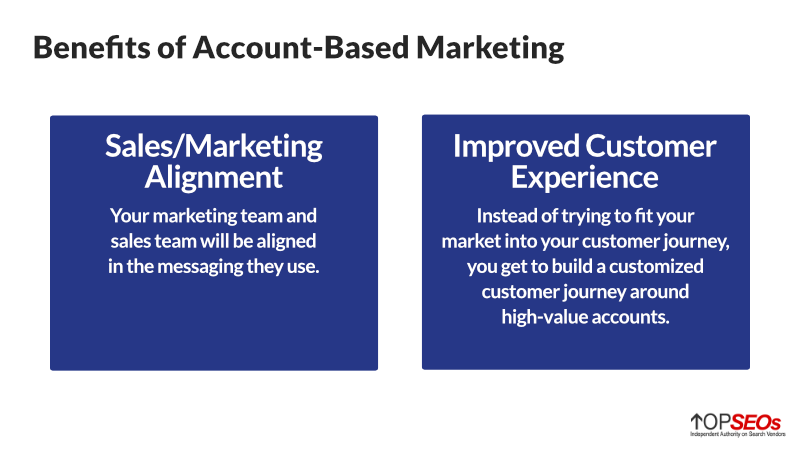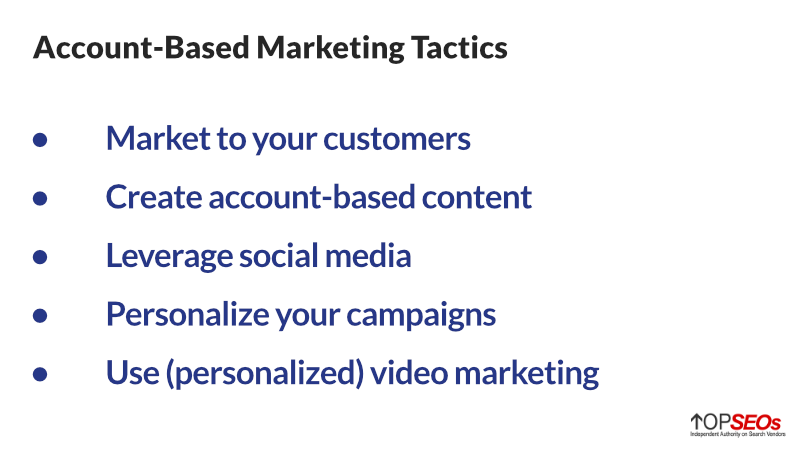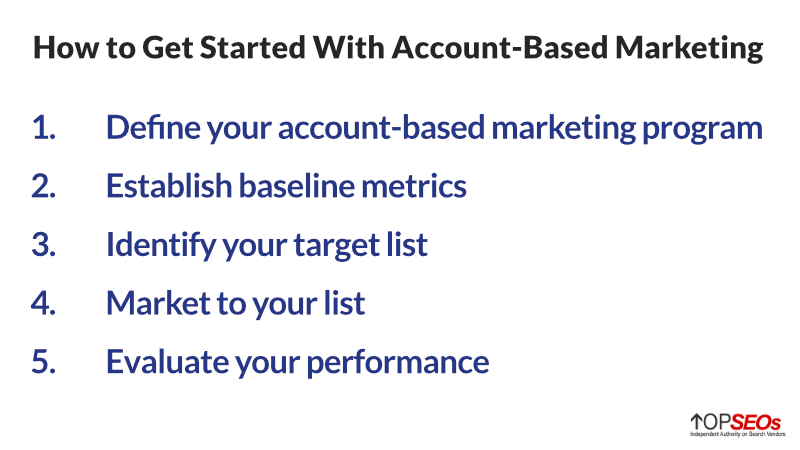Account-based marketing is nothing new, but the term’s popularity has increased over the past several years.
Account-based marketing is intended to align the sales and marketing process, making it easier to nurture and maintain relationships with a targeted set of accounts.
There’s a lot that goes into account-based marketing: account mapping, offers, metrics, and aligning sales and marketing.
From this article, you’ll get a crash course for getting started with account-based marketing along with the top five account-based marketing tactics you should be using.
What Is Account-Based Marketing (ABM)?
Account-based Marketing (ABM) is a highly targeted strategy that aligns sales and marketing to create a personalized buying experience for high-value accounts. Essentially, it means treating individual high-value accounts as if they’re a market all on their own.
This level of personalization and individual attention lets you create a very specific customer journey and customize your campaigns and content to specific accounts, leading to increased customer loyalty and a better ROI.

Why use account-based marketing? Here are a couple of benefits of using ABM that you’ll probably appreciate.
Sales And Marketing Alignment
With ABM, your focus is on accounts, not leads. That means that your marketing team and sales team are going to be aligned in the messaging they use.
Instead of having your marketing team creating content and campaigns for entire industries while sales focus on converting highly qualified leads, you can draw on the expertise from both teams to reach targeted accounts that are more likely to convert.
And ABM works. According to Forrester Research, aligned sales and marketing teams enjoy average annual revenue growth of 32%, compared to a 7% decline for companies that don’t align sales and marketing.
Improved Customer Experience
ABM lets you create personalized touchpoints along the entire customer journey. Instead of trying to fit your market into your customer journey, you get to build a customized customer journey around high-value accounts.
5 Account-Based Marketing Tactics
The account-based marketing tactics included here will help you create a strong foundation for your ABM strategy.

1. Market to Your Customers
Account-based marketing takes your existing sales funnel and turns it on its head, so if your current marketing strategy places heavy emphasis on lead generation, ABM is going to be a little switch in thinking.
Instead of casting a wide net as you do with lead generation tactics, ABM starts with taking a deep dive into your existing customers.
Look for patterns in your customers with the highest lifetime value. Here are some questions to ask about your most valuable customers:
- Where do they enter your sales funnel?
- What do they value about you and your business?
- Do they share a common pain point?
- Are they in a particular industry?
Once you’ve identified patterns in your existing high-value customers you’ll be able to leverage that information to create content that is meaningful to them. This makes it easier to attract more customers like them (and maybe even reduce churn for existing customers).
2. Create Account-Based Content
Once you have a better idea of what type of customer you want to target, you’ll need to create content specifically for them. Consider your brand’s unique value proposition and create something of value that you can provide to potential customers.
So, what makes account-based content marketing different from regular content marketing?
Typically, marketers use content to pull in potential customers. Most of the content we create is used for lead generation, link building, brand awareness, or driving top-of-the-funnel traffic.
When you create content for account-based marketing, on the other hand, you’re creating content that is highly custom and specialized. This content isn’t designed to get broad attention, it’s designed to get the attention of a single customer (or very small group of customers).
3. Leverage Social Media
Yes, you can still use social media for account-based marketing. In fact, social media makes it a little easier to connect to your target customers.
Once you have a list of target accounts, you’ll need to find their accounts across social media platforms. Start following and engaging with them on social media and pay attention to what they do.
When you’re just starting out with ABM it can feel a little strange. You’re basically following specific accounts around to spy on them.
But it’s important.
You want to understand how they use social media so you can begin engaging with them more directly.
Here are some easy ways to learn about and engage with your ABM targets:
- Share their content
- Reply to their posts
- Join groups that they’re part of
- Send them messages
4. Personalize Your Campaigns
Personalization makes a big difference. According to eConsultancy, 74% of marketers say that personalization increases customer engagement. And, DMA reports that segmented and targeted emails are responsible for 58% of all revenue.
We’ll say it again: personalization makes a big difference.
But how do you incorporate personalization into your account-based marketing strategy? Here are a few ways:
- Use segmentation and merge tags
- Map your content to each step in the customer journey
- Personalize both inbound and outbound campaigns
- Personalize your ad campaigns across platforms
- Take advantage of targeting tools on the platforms you use
5. Use (Personalized) Video Marketing
A staggering 85% of marketers say that video is an effective way to get attention online (Animoto). But consider this: only 35% of viewers stick with a video to the end, according to HubSpot.
Add personalization to the mix and that number skyrockets.
The average retention rate for personalized videos is 35% higher than non-personalized videos.
So, how can you use video marketing in your account-based marketing strategy?
For starters, try incorporating a video into your cold emails instead of relying on the same old copy that everyone uses. Video content is a great way for prospects to get to know your personality and it shows them that there are real people behind your product.
Real people who took the time to create a video for them. That’s some dedication.
Fortunately, it doesn’t have to be a huge expense.
We recommend keeping your ABM videos simple. The point is to build relationships, not create the next blockbuster action film.
There are several ways you can add videos to your ABM marketing strategy:
- A welcome or check-in message
- Invitation to a meeting, demo, or webinar
- To say thank you
Of course, there are other ways to add videos to your ABM marketing efforts; this list is by no means exhaustive.
One of the most effective ways to use video is to create customized video content that maps to your different market segments wherever they are in their customer journey. Plus, video is great for bringing AWOL prospects back into the fold.
Getting Started With Account-Based Marketing
Now that you’re familiar with some account-based marketing tactics, it’s time to put it all together and actually start ABM.
But how? Where to start? How much is this going to cost? Do you need to hire an entirely new team of account-based marketing experts?
Don’t worry. Putting ABM into practice isn’t that hard. You can actually do it pretty quickly and painlessly.

Here are the five steps to getting started with account-based marketing.
1. Define Your ABM Program
Starting an account-based marketing program is exciting. You’ll probably want to jump in with both feet, but we urge you to start small.
Learn from your small-scale ABM program, make adjustments, then scale your efforts. This will save you from spending the time and energy to build a program that you find you can’t maintain.
The very first step to getting started with account-based marketing is to create an outline of what you want your ABM program to look like.
Really take the time to figure out what pain points you want to address and the tactics you will use to do that. Then, decide on a timeframe for your program and establish metrics to help you measure your program’s success.
2. Establish Baseline Metrics
Now that you’ve decided on your basic account-based marketing program framework and what success looks like, you’ll want to establish baseline metrics to measure your performance against.
Gather data for the metrics and business outcomes you identified in your ABM program outline. This is your starting point.
Here are some common account-based marketing program metrics:
- Web traffic by account: (Target Account Website Visits/Total Website Visits) = Web Traffic by Target Account
- Target account reach: (Decision-Makers Engaged/Total Decision Makers at Target Account) = Target Account Reach
- Marketing-qualified and sales-qualified accounts
- Deal velocity: ([Total Opportunities x Average Deal Size x Conversion Rate]/Sales Cycle Length) = Deal Velocity
- Average contract value: (Total Customer Contract Value/Total New Customers) = Average Contract Value
- Cross-sells: (Total Customers Cross-Sold/Total Customers) = Cross-Sells
- Upsells: (Total Customers Up-Sold/Total Customers) = Upsells
- Referred customers: (Referred Customers/Total Customers) = Percent Referred Customers
- Referring customers: (Customers Who Have Referred a Peer/Total Customers) = Percent Referring Customers
- Net Promoter Score/NPS
3. Identify Your Target List
For your first account-based marketing program, limit yourself to a single target list so you can focus your attention to get the best results.
The size of the target list you choose for your first ABM program depends on a few things: what you can handle, the needs of your business, and the marketing tactics you plan to use.
If you’re planning to use specialized resources that require several touches from your team, you’ll want to keep your initial program small.
4. Market to Your List
It’s finally time to put your account-based marketing program into action!
Before you officially get started, though, be sure to go through one last evaluation of your program. Is everything as targeted as it can be to reach only those on your target list?
If yes, then you’re ready to go!
If not, what are you missing? What areas can be tightened up?
5. Evaluate Your Performance
Once your account-based marketing program is up and running, start monitoring your metrics and evaluating your performance.
It’s important to remember that your performance for some of your metrics and outcomes aren’t going to become apparent right away.
Traditional marketing may be evaluated based largely on things like traffic, leads, and click-through rates that are quick to show changes, but account-based marketing tends to take more time since it depends on your sales cycle.
This means that some of your account-based marketing metrics will show results quickly, but you need to be patient for things like business outcomes.
Once your ABM program runs its course, you’ll want to analyze not only what you achieve, but how you achieved it. Your goal is to learn from this process so you can improve on it next time.
Wrapping Up
With all the tools, data, and formulas that go into account-based marketing, it’s easy to forget that people are at the core of it. No matter your target audience or who ends up on your target list, they’re still people. And so are you.
It’s important to keep in mind that marketing—all marketing—is about building relationships with the people who can benefit most from your products or services.




















